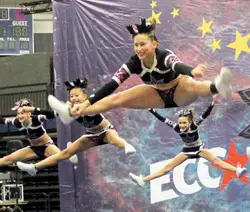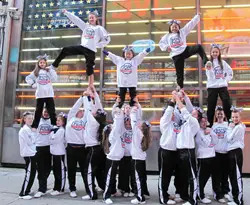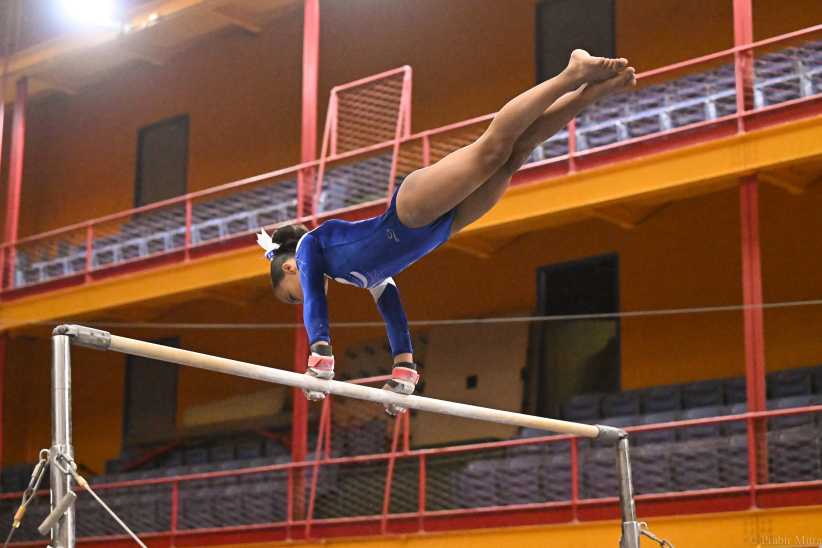Whether it’s a school program or an all-star squad, cheerleading makes real athletic demands of participants—and not always on the sidelines. Only serious athletes need apply.
High school cheerleaders can often get overlooked as sports stars. Dressed in mini-skirts and tight tops, they’re often plagued by the “ditzy cheerleader” stereotype. At the very least, it may be hard for the athletes to stand out while performing during high school sporting events.
Those who participate on regional competitive teams may be overlooked completely because they spurn the traditional school setting and only “cheer” several seconds per routine.

“Cheerleading is great exercise, building aerobic endurance and muscle strength,” says Regina Albano, who coaches and directs the all-star program at Gymnastics City in Cortlandt Manor.
Traditional cheerleading routines include dance moves, tumbling patterns, jumping artistry, and lifts that require great stamina. In addition to practicing the carefully choreographed routines, cheerleaders often run and lift weights to make sure they have the endurance they need to complete their programs.
Typically cheerleaders all come from the same school and must memorize cheers and pay attention to the athletic event in front of them so that they don’t cheer at an inopportune time (like when one of the athletes on the field is injured) or use a cheer that’s not appropriate for the situation (such as cheering for your team to stop a scoring attempt when it’s on offense). These cheerleaders also focus more on cheerleading motions and making the games they cheer at an interactive event for fans to experience in a way they couldn’t if the cheerleaders weren’t present.
All-star teams, which are usually only made up of the best cheerleaders from surrounding areas, up the ante. Their routines—which contain little cheering but contain the same tumbling, stunting, and dances, and add flashy pyramids—can be up to two-and-a-half minutes long and are performed to music.
These cheerleaders will never support their local school, but their training is equally, if not more, intense. Like athletes who participate in travel sports, they often compete for 10 to 11 months of the year. During this period, they practice two to three times per week for up to three hours. Additionally, most all-star teams require the athletes to take tumbling classes. The payoff? The team competes in weekend-long events up to 10 times per year throughout the country.
Making the Cut
Regardless of which team the athletes belong to, proper strength-training, stretching, and warm ups are essential for injury prevention, says Michael Bachman, a pediatrician at PM Pediatrics, which has offices in Long Island, Westchester, and Queens.
“The most common injuries related to cheerleading are strains and sprains,” says Dr. Bachman, who also cautions that dislocations and fractures could occur. And, in rare instances, there are fall-related injuries, which may include head, neck, and back trauma.
The seriousness of head, neck, and back injuries may be one of the reasons that all-star coaches look for good tumbling and stunting techniques. Strong, technically sound athletes are less likely to sustain a severe injury or contribute to a teammate’s injury.
Students interested in participating on their high school team should be able to tumble, perform jumps, and have good motion techniques. Effort and commitment are important at this level because coaches look to build a complete team with athletes that complement one another other.
Those who don’t make the cut may need to take a tumbling class, get stronger, or talk to the coaches about their weaknesses and the team’s future needs.
“Cheerleading isn’t just a team sport,” Albano says. “The athletes really have to work together as one. It’s more like a puzzle—if there is one piece missing, it won’t work. They have to trust each other and work together. When you are lifting girls and tumbling right next to each other, you have to trust that everyone is doing what they’re supposed to be doing at the right time.”
Team Dynamics—and Boys
One trend that’s changing the dynamic of teams across the nation that Albano has witnessed first-hand is the addition of male cheerleaders to many rosters. Although boys who participate may face different emotional challenges than girls, males experience the same physical and emotional benefits from being part of the group.
“Parents should support their children and help them develop positive self-esteem,” says Bachman, who encourages children to participate in sports, especially those they excel in, to build their self worth.
Parental support doesn’t guarantee that male cheerleaders won’t be tormented by their peers. It is an unfortunate reality that there are those who question the sexuality of boys who are interested in joining high school cheerleading teams, and may do so loudly. Parents, beyond lending support, should offer tips on how to deal with bullies. Bachman suggests that children address a bully directly, tell him to stop—being sure to avoid physical retaliation—and report the incident. If parents are aware of bullying, they can work with school leaders to develop anti-bullying programs that educate students and parents about the short- and long-term effects of bullying.

Albano, who coached a team with male cheerleaders for the first time last year, immediately noticed a difference in the group’s dynamic. The girls, who were learning new stunts and choreography, were a little distracted at first, but the team’s collective confidence soared.
“It helps make the team feel they can do better,” says Albano, who noted the boys’ strength and athleticism was unparalleled.
Another local team has had several boys on their roster for the last few years. “My observation of the boys on their team is that they seem like leaders and role models,” Albano says. “They motivate the girls, and the team seems like a big, happy family.”



















